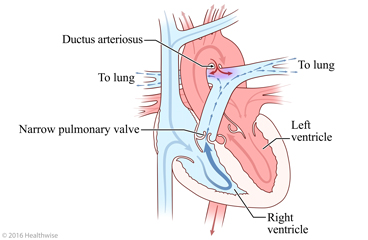
What is pulmonary valve stenosis?
Pulmonary valve stenosis is a type of congenital heart disease. Congenital heart disease refers to heart problems a baby is born with. These heart problems are usually diagnosed at or before birth.
"Pulmonary" means "of the lungs."The pulmonary artery takes the blood from the heart to the lungs to pick up new oxygen. The pulmonary valve is the gate through which the heart pumps blood into the pulmonary artery.
"Stenosis" means "narrowed." In pulmonary valve stenosis, that gate is too narrow. The heart has to work harder to push blood through it. It also means less blood gets to the lungs. So the blood going out to the body doesn't have enough oxygen.
Even though the gate is too narrow, the baby's body is still able to get some oxygen. That's because there's a small blood vessel that connects the left and right sides of the heart. This blood vessel is called the ductus arteriosus. It is part of the circulation system before birth. It usually closes shortly after birth. But medicine can keep it open until the valve can be repaired. As long as it stays open, red blood mixes with blue blood so that at least some oxygen goes out to the baby's body.
A baby with pulmonary valve stenosis may also have other heart problems.
Your baby may need special care, such as being in the neonatal intensive care unit (NICU). This may be scary for you. But the hospital staff understands this. They will explain what happens and will answer your questions.
How is pulmonary valve stenosis diagnosed?
Your doctor may hear abnormal heart sounds, such as a heart murmur, when examining your newborn.
Your doctor will order tests to find the cause of abnormal heart sounds or symptoms. The most common test is an echocardiogram, or "echo" for short. It uses sound waves to make an image of your baby's heart.
Other tests, such as an EKG (electrocardiogram), chest X-ray, and checking the amount of oxygen in the blood, also help identify the problem.
A fetal ultrasound, which looks at the baby's heart, may find this problem before birth.
What are the symptoms?
When the narrowing of the valve is severe, the baby may have a blue tint to the skin. This is because not enough oxygen is getting to the baby's body.
How is it treated?
Your doctor will help you understand your treatment choices and what to expect from each choice.
Your baby may get medicine to keep the ductus arteriosus open. The medicine may be given through a blood vessel in the belly button.
Your doctor may use a procedure called a valvuloplasty (say "VAL-vyoo-loh-plas-tee") to stretch the valve so that it is more open. Your baby will be asleep during this procedure. The doctor puts a thin tube into a blood vessel in your baby's groin or umbilical cord. This tube is called a catheter. It contains a tiny uninflated balloon. The doctor moves the catheter through the blood vessel to the heart. The doctor feeds the balloon into the valve and then inflates it for a short time to stretch open the valve.
Surgery may be done to repair or replace the valve.
What can you expect?
- You may see tubes and wires attached to your baby. This can be scary to see. But these things help the doctor treat your baby. The tubes supply air, fluid, and medicines to your baby. The wires are attached to machines that help the doctor keep track of your baby's vital signs. These include temperature, blood pressure, breathing rate, and pulse rate.
- If your baby has trouble breathing, the doctor may use a ventilator. This machine helps your baby breathe. To use the machine, the doctor puts a soft tube through your baby's mouth into the windpipe.
- The hospital staff will give your baby the nutrition that your baby needs. The doctor may feed your baby through a soft tube that goes through the nose and into the stomach. Or the doctor may use an I.V. that goes through the belly button to do this.
- Your baby may need oxygen. It is given to the baby through a tube in the nose or throat.
- Your baby will be kept comfortable and warm.
- It may seem that your baby is getting lots of tests. All of these tests help your doctor keep track of your baby's condition and give the best treatment possible.
- After treatment, your baby will need routine checkups to check the heart.
- It's hard to be apart from your baby, especially when you worry about your baby's condition. Know that the hospital staff is well prepared to care for babies with this condition. They will do everything they can to help. If you need it, ask for support from friends and family. You can also ask the hospital staff about counselling and support.
Follow-up care is a key part of your child's treatment and safety. Be sure to make and go to all appointments, and call your doctor or nurse advice line (811 in most provinces and territories) if your child is having problems. It's also a good idea to know your child's test results and keep a list of the medicines your child takes.
Where can you learn more?
Go to https://www.healthwise.net/patientEd
Enter T754 in the search box to learn more about "Learning About Severe Pulmonary Valve Stenosis in Newborns".
